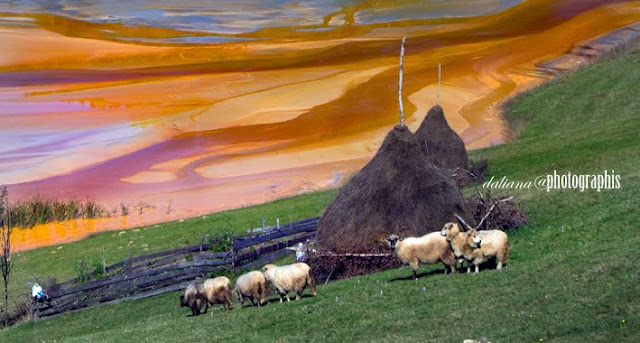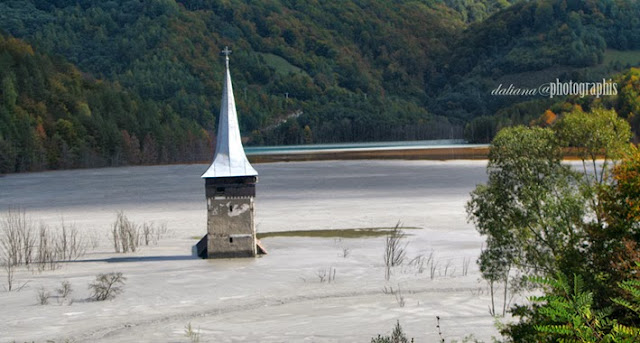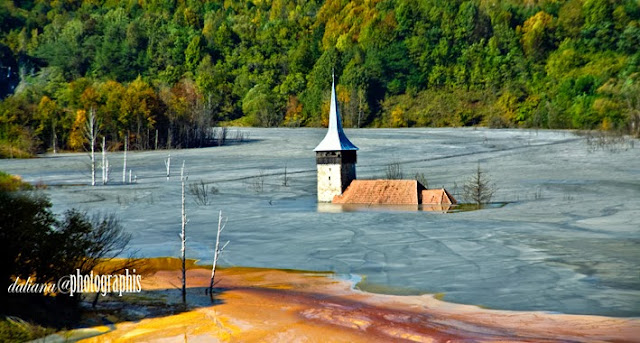'Cândva, la Geamăna, în munţii Apuseni era un sat. Acum e acoperit aproape în totalitate de deşeuri provenite de la cariera de cupru de la Roşia Poieni. Localnicii au fost obligaţi să se mute de la un an la altul tot mai sus de vatra satului, pentru a scăpa de invazia sterilului, care în timp le-a acoperit biserica, le-a înghiţit cimitirul.
Schimbarea la faţă a zonei a început în anul 1977, când Nicolae Ceauşescu a decis să dea drumul exploatării de cupru de la Roşia Poieni. La acea vreme era cea mai mare din Europa. La început, locuitorii celor aproape 400 de case şi-au imaginat, probabil, că se vor îmbogăţi, însă n-a fost chiar aşa. La începutul anilor 1980, au fost expropriate de statul român peste 300 de familii din Geamăna. Sumele primite au fost în funcţie de proprietăţi.
În 1986, când a început deversarea sterilului, trăiau aici peste 1.000 de persoane. Acum, în căsuţele moţeşti, răsfirate de-a lungul a câţiva kilometri, în jurul lacului în care ajunge tulbureala de steril de la cariera de cupru, mai trăiec 20 de suflete. Casele rămase au fost aşezate de destin mai deasupra, pe culme, cum spun localnicii. Tot pe deal a fost ridicată şi biserica satului, cam la 100 de metri de vatra satului. Este unul din puţinii martori care ne arată că aici a fost odată o aşezare omenească. Nămolul a ajuns,însă, la nivelul acoperişului. Sub biserică, în valea Şeşii, se află lacul cu tulbureala de steril, înroşit de deşeurile de la cariera de cupru de la Roşia Poieni. Aici a fost până în urmă cu aproape trei decenii vatra satului Geamana.'
Schimbarea la faţă a zonei a început în anul 1977, când Nicolae Ceauşescu a decis să dea drumul exploatării de cupru de la Roşia Poieni. La acea vreme era cea mai mare din Europa. La început, locuitorii celor aproape 400 de case şi-au imaginat, probabil, că se vor îmbogăţi, însă n-a fost chiar aşa. La începutul anilor 1980, au fost expropriate de statul român peste 300 de familii din Geamăna. Sumele primite au fost în funcţie de proprietăţi.
În 1986, când a început deversarea sterilului, trăiau aici peste 1.000 de persoane. Acum, în căsuţele moţeşti, răsfirate de-a lungul a câţiva kilometri, în jurul lacului în care ajunge tulbureala de steril de la cariera de cupru, mai trăiec 20 de suflete. Casele rămase au fost aşezate de destin mai deasupra, pe culme, cum spun localnicii. Tot pe deal a fost ridicată şi biserica satului, cam la 100 de metri de vatra satului. Este unul din puţinii martori care ne arată că aici a fost odată o aşezare omenească. Nămolul a ajuns,însă, la nivelul acoperişului. Sub biserică, în valea Şeşii, se află lacul cu tulbureala de steril, înroşit de deşeurile de la cariera de cupru de la Roşia Poieni. Aici a fost până în urmă cu aproape trei decenii vatra satului Geamana.'
historia.ro
Once, Geamăna was a village in the Apuseni Mountains . Now is covered almost entirely by waste from copper career at Rosia Poieni . Residents
were forced to move above the
village to escape the poison invasion that covered the church
and cemetery.
The Changing Face of the area began in 1977 , when Nicolae Ceausescu decided to release copper exploitation at Rosia Poieni . At that time it was the largest in Europe. At first , residents of about 400 homes have imagined perhaps that will enrich , but it was not so . In the early 1980s , was expropriated by the Romanian over 300 families from the village. The amounts received were based on the properties .
In 1986, when began the tailing discharge , 1,000 people lived here . Almost 20 souls are living now in the little wooden houses , scattered along the several kilometers around the lake .The remaining houses were placed by Destiny on the hill, as the locals say . Also on the hill was built the village church , about 100 meters from the center of the village . It is one of the few witnesses who shows us that there was once a human settlement . The slurry reached , however, on the roof . Under the church, in Sesia Valley lies tailings lake , crimson career copper waste from Rosia Poieni . This was until about three decades ago, the hearth of the Geamăna Village .
Images taken from another world, which can be compared with the moon made public by the U.S. space agency . Trees dry out of the swamp filled with lime surrounded by a yellowish- white , sometimes gray water . Homes were in the middle of the valley . Here the hills was filled with apple, plum . Were gone.
A church buried in the gray shore , of which only remaining tower and roof , surrounded by wreaths of dry trees , which were swallowed along with the local cemetery . In the distance the lake is blood red .
The Changing Face of the area began in 1977 , when Nicolae Ceausescu decided to release copper exploitation at Rosia Poieni . At that time it was the largest in Europe. At first , residents of about 400 homes have imagined perhaps that will enrich , but it was not so . In the early 1980s , was expropriated by the Romanian over 300 families from the village. The amounts received were based on the properties .
In 1986, when began the tailing discharge , 1,000 people lived here . Almost 20 souls are living now in the little wooden houses , scattered along the several kilometers around the lake .The remaining houses were placed by Destiny on the hill, as the locals say . Also on the hill was built the village church , about 100 meters from the center of the village . It is one of the few witnesses who shows us that there was once a human settlement . The slurry reached , however, on the roof . Under the church, in Sesia Valley lies tailings lake , crimson career copper waste from Rosia Poieni . This was until about three decades ago, the hearth of the Geamăna Village .
Images taken from another world, which can be compared with the moon made public by the U.S. space agency . Trees dry out of the swamp filled with lime surrounded by a yellowish- white , sometimes gray water . Homes were in the middle of the valley . Here the hills was filled with apple, plum . Were gone.
A church buried in the gray shore , of which only remaining tower and roof , surrounded by wreaths of dry trees , which were swallowed along with the local cemetery . In the distance the lake is blood red .
legenda-comunei-inecate-in-otravurile-din-valea-sesei-blestemul-preotului-a-ingropat-geamana-sub-iazul-de-la-cuprumin-612008.html
http://bogdanbalaban.ro/index.php?action=articole_full&id=346
Romania is a beautiful country located at the intersection between central and southeastern Europe, and it is actually the eighth largest country of the European Union by area, measuring a total of 92,043 square miles. As far as tourism is concerned, Romania boasts a wide array of attractions, including historical landmarks such as castles or very old forts, beautiful mountains, beaches and fantastic roads.











10 comments:
iar peste 20 de ani o sa spunem o poveste similara care are sa inceapa cu a fost candva aici un sat numit Rosia Montana.
Uff, multumim pentru imagini. Tristetea e pe masura frumusetii naturale a locurilor alora!
Un-natural colors.
Caused by flooding?
The photograph of the church roof and steeple rising from the lake bring thoughts of James Dickey's novel and the subsequent film, "Deliverance," into my mind. In the film, a cemetery is being moved as water rises and advances in a reservoir newly-created by the damming of a river. Places, as well as people, die, but it is not something easy to understand or to accept.
The earth is full of places where mankind's greed or ignorance or avarice have left scars which will take generations to erase. It is all the worse when people are made to sacrifice and to suffer because of it.
Your photography is excellent, as it always is, Daliana. Perhaps, too excellent in this instance, as it reflects only sadness and sorrow.
This is awful.
A picture of hell.
Impresionantes sitios.
Saludos
Love colors! greetings.
I am amazed. Speechless. This is one of the worst things I have ever heard of, even if in China right now, there are apparently many places just as bad.
It is difficult to imagine that this is the work of human beings.
Such photography is absolutely essential, thank you for it. Those photographs are true art stemming out of horror.
Roger
Un trist bilant...Fotografii de exceptie, cum ne-ai obisnuit.
Dramatic photographs of greed.
sunt niste imagini splendide!
Post a Comment